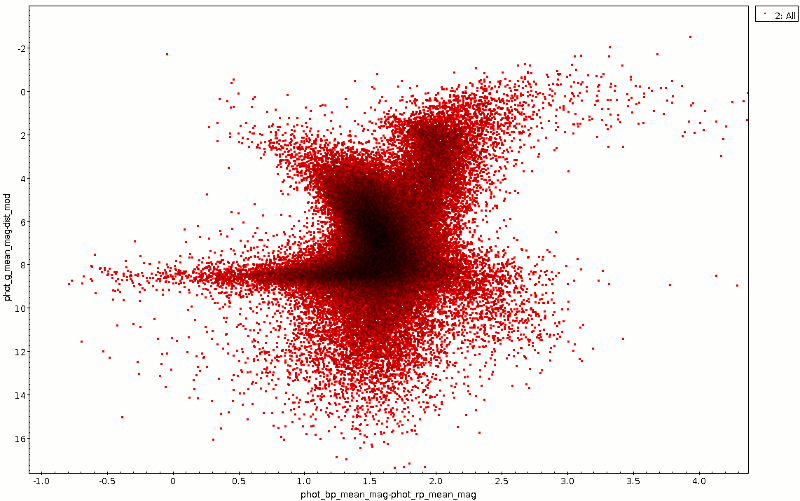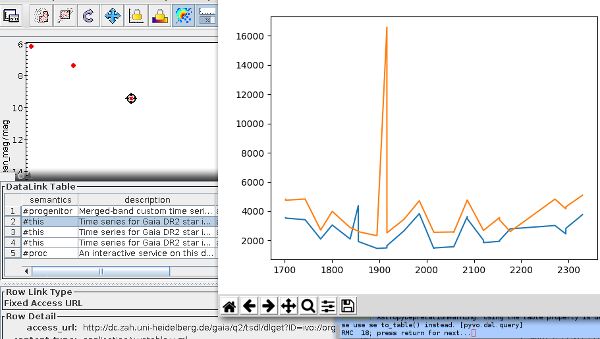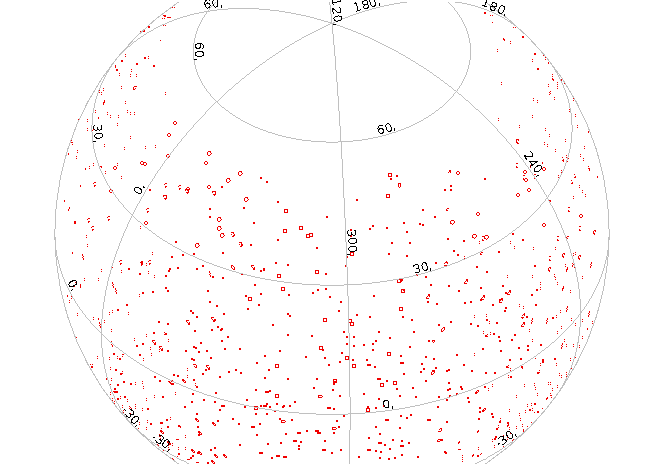Find Outliers using ADQL and TAP

Two pages from Annie Cannon's notebooks[1], and a histogram of the basic BP-RP color distribution in the HD catalogue (blue) and the distribution of the outliers (red). For more of Annie Cannon's notebooks, search on ADS.
The other day I gave one of my improvised live demos (“What, roughly, are you working on?”) and I ended up needing to translate identifiers from the Henry Draper Catalogue to modern positions. Quickly typing “Henry Draper” into TOPCAT's TAP search window didn't yield anything useful (some resources only using the HD, and a TAP service that didn't support uploads – hmpf).
Now, had I tried the somewhat more thorough WIRR Registry interface, I'd have noted the HD catalogue at VizieR and in particular Fabricius' et al's HD-Tycho 2 match (explaining why they didn't show up in TOPCAT is a longer story; we're working on it). But alas, I didn't, and so I set out to produce a catalogue matching HD and Gaia DR2, easily findable from within TOPCAT's TAP client. Well, it's here in the form of the hdgaia.main table in our data center.
Considering the nontrivial data discovery and some yak shaving I had to do to get from HD identifiers to Gaia DR2 ones, it was perhaps not as futile an exercise as I had thought now and then during the preparation of the thing. And it gives me the chance to show a nice ADQL technique to locate outliers.
In this case, one might ask: Which objects might Annie Cannon and colleagues have misclassified? Or perhaps the objects have changed their spectrum between the time Cannon's photographic plates have been taken and Gaia observed them? Whatever it is: We'll have to figure out where there are unusual BP-RPs given the spectral type from HD.
To figure this out, we'll first have to determine what's “usual”. If you've worked through our ADQL course, you know what to expect: grouping. So, to get a table of average colours by spectral type, you'd say (all queries executable on the TAP service at http://dc.g-vo.org/tap):
select spectral, avg(phot_bp_mean_mag-phot_rp_mean_mag) as col, count(*) as ct from hdgaia.main join gaia.dr2light using (source_id) group by spectral
– apart from the join that's needed here because we want to pull photometry from gaia, that's standard fare. And that join is the selling point of this catalog, so I won't apologise for using it already in the first query.
The next question is how strict we want to be before we say something that doesn't have the expected colour is unusual. While these days you can rather easily use actual distributions, at least for an initial analysis just assuming a Gaussian and estimating its FWHM as the standard deviation works pretty well if your data isn't excessively nasty. Regrettably, there is no aggregate function STDDEV in ADQL (you could still ask for it: head over to the DAL mailing list before ADQL 2.1 is a done deal!). However, you may remember that Var(X)=E(X2)-E(X)2, that the average is an estimator for the expectation, and that the standard deviation is actually an estimator for the square root of the variance. And that these estimators will work like a charm if you're actually dealing with Gaussian data.
So, let's use that to compute our standard deviations. While we are at it, throw out everything that's not a star[2], and ensure that our groups have enough members to make our estimates non-ridiculous; that last bit is done through a HAVING clause that essentially works like a WHERE, just for entire GROUPs:
select spectral,
avg(phot_bp_mean_mag-phot_rp_mean_mag) as col,
sqrt(avg(power(phot_bp_mean_mag-phot_rp_mean_mag, 2))-
power(avg(phot_bp_mean_mag-phot_rp_mean_mag), 2)) as sig_col,
count(*) as ct
from hdgaia.main
join gaia.dr2light
using (source_id)
where m_v<18
group by spectral
having count(*)>10
This may look a bit scary, but if you read it line by line, I'd argue it's no worse than our harmless first GROUP BY query.
From here, the step to determine the outliers isn't big any more. What the query I've just written produces is a mapping from spectral type to the means and scales (“µ,σ” in the rotten jargon of astronomy) of the Gaussians for the colors of the stars having that spectral type. So, all we need to do is join that information by spectral type to the original table and then see which actual colors are further off than, say, three sigma. This is a nice application of the common table expressions I've tried to sell you in the post on ADQL 2.1; our determine-what's-usual query from above stays nicely separated from the (largely trivial) rest:
with standards as (select spectral,
avg(phot_bp_mean_mag-phot_rp_mean_mag) as col,
sqrt(avg(power(phot_bp_mean_mag-phot_rp_mean_mag, 2))-
power(avg(phot_bp_mean_mag-phot_rp_mean_mag), 2)) as sig_col,
count(*) as ct
from hdgaia.main
join gaia.dr2light
using (source_id)
where m_v<18
group by spectral
having count(*)>10)
select *
from hdgaia.main
join standards
using (spectral)
join gaia.dr2light using (source_id)
where
abs(phot_bp_mean_mag-phot_rp_mean_mag-col)>3*sig_col
and m_v<18
– and that's a fairly general pattern for doing an initial outlier analysis on the the remote side. For HD, this takes a few seconds and yields 2722 rows (at least until we also push HDE into the table). That means you can keep 99% of the rows (the boring ones) on the server and can just pull the ones that could be interesting. These 99% savings aren't terribly much with a catalogue like the HD that's small by today's standards. For large catalogs, it's the difference between a download of a couple of minutes and pulling data for a day while frantically freeing disk space.
By the way, that there's only 2.7e3 outliers among 2.25e5 objects, while Annie Cannon, Williamina Fleming, Antonia Maury, Edward Pickering, and the rest of the crew not only had to come up with the spectral classification while working on the catalogue but also had to classify all these objects manually. This is an amazing feat even if all of those rows actually were misclassifications (which they certainly aren't) – the machine classifiers of today would be proud to only get 1% wrong.
The inset in the facsimile of Annie Cannons notebooks above shows how the outliers are distributed in color space relative to the full catalogue, where the basic catalogue is in blue and the outliers (scaled by 70) in red. Wouldn't it make a nice little side project to figure out the reason for the outlier clump on the red side of the histogram?
| [1] | The notebook pages are from a notebook Annie Cannon used in 1929. The material was kindly provided by Project PHAEDRA at the John G. Wolbach Library, Harvard College Observatory. |
| [2] | I'll not hide that I was severely tempted to undo the mapping of object classes to – for HD – unrealistic magnitudes (20 .. 50) but then left the HD as it came from ADC; I still doubt that decision was well taken, and sure enough, the example query above already has insane constraints on m_v reflecting that encoding. From today's position, of course there should have been an extra column or, better yet, a different catalogue for nonstellar objects. Ah well. It's always hard to break unhealty patterns. |

![[RSS]](../theme/image/rss.png)


